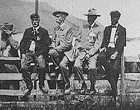The war's most immediate legacy was growth: the federal government, the population, and the country itself all got bigger. The size and role of the federal government began a dramatic expansion, starting a trend that has never reversed. In 1860, the last full year before the fighting began, the federal budget was $78 million. By 1867, the first year in which the war could be eliminated as a major economic factor, the federal budget had grown almost fivefold, to $376.8 million. Federal spending never again dipped below $300 million a year.
The Republican commitment to aggressive federal action to spur economic development was apparent from the war's outset. In 1862 alone, Congress passed the Homestead Act, the Morrill Land Grant Colleges Act, and the Pacific Railway Act, all of which helped pave the way for postwar industrialization, urbanization, and westward expansion. In the war's aftermath, a succession of Republican administrations-only Grover Cleveland [twice] broke the party of Lincoln's hold on the White House before Woodrow Wilson's 1912 victory over a fractured Republican Party-continued the high tariffs and other economic policies friendly to business that signaled an unwavering commitment to capitalism. Legal scholars posit that this political victory of the Republicans was paralleled by a judicial revolution, a veritable "Second American Republic," with a strong nation-state governing a populace of national--not state--citizens, whose rights would be guaranteed by the federal authorities.
| Year | Population | Growth over past decade | % Growth over past decade | % urban population |
|---|---|---|---|---|
| 1860 | 31,443,321 | 19.8 | ||
| 1870 | 38,558,371 | 7,115,050 | 22 | 25.7 |
| 1880 | 50,189,209 | 11,630,838 | 30 | 28.2 |
| 1890 | 62,979,766 | 12,790,557 | 25 | 35.1 |
| 1900 | 76,212,168 | 13,232,402 | 21 | 39.6 |
| Year | Immigration totals over past decade | Immigration as % of growth over past decade |
|---|---|---|
| 1870 | 2,134,824 | 32.5 |
| 1880 | 2,812,191 | 24 |
| 1890 | 5,246,613 | 41 |
| 1900 | 3,687,564 | 28 |
| Year Range | Growth over range | % Growth over range | Immigration totals over range | Immigration as % of growth over range |
|---|---|---|---|---|
| 1860-1900 | 44,768,847 | 142 | 14,061,192 | 31 |
Table 2,3 and 4 U. S. Population Growth and Immigration, 1860 through 1900
As the table above illustrates, the nation's population growth kept pace with that of the central government. The completion of the transcontinental railroad in 1869, the elimination of the threat of the extension of slavery, and the surge of immigration in the four decades after the war all spurred expansion to the Pacific coast. In the thirty years after the war's end, ten new states were admitted into the union. The country's population grew 142 percent between 1860 and 1900; 31 percent of that growth was due to immigration. The percentage of the population that was classified as city dwellers doubled, from 19.8 percent in 1860 to 39.6 percent in 1900, marking the emergence of an industrial, urban, increasingly diverse and economically dynamic nation.



